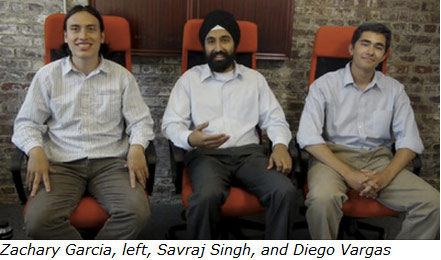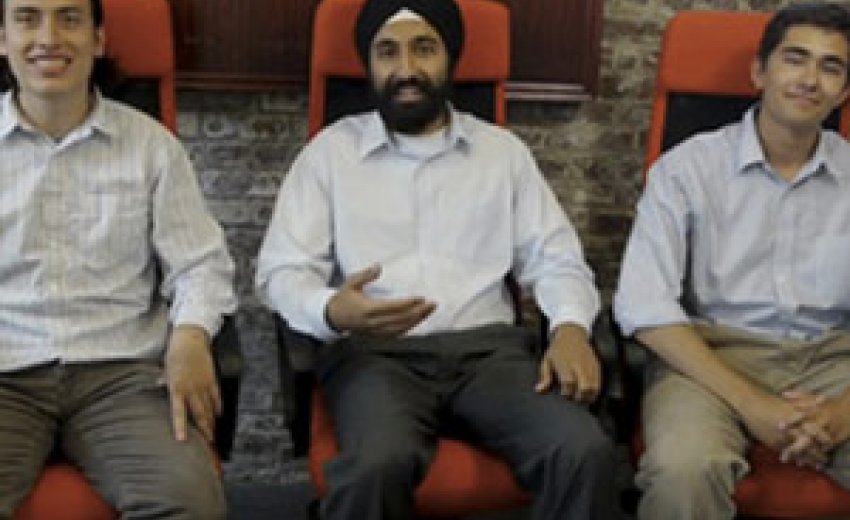 Savraj Singh understands the power of collaboration. In 2008 — just five years after graduating from Princeton University — Singh created an energy monitor from scratch and shared his invention with his friends. Impressed with the product, they suggested that Singh start a business making and selling the monitor.
Savraj Singh understands the power of collaboration. In 2008 — just five years after graduating from Princeton University — Singh created an energy monitor from scratch and shared his invention with his friends. Impressed with the product, they suggested that Singh start a business making and selling the monitor.
Encouraged by their advice and his own vision, Singh set up shop in his Pennington basement, which would become home for his company, Wattvision. With backing from Y Combinator — a company that provides seed money and advice to startups — he started his business in January, 2009. Now he is now preparing to launch Version 2 of the product.
“Wattvision helps you save money on energy by giving you a live view of how much energy you are using,” said Singh in an interview from a hotel room in California where he was attending a technology conference.
Wattvision works by collecting data from your electricity meter. You mount your Wattvision Energy Sensor to the outside of your meter, connect the Wattvision gateway to your network, and then go online from your computer or mobile device to view your real-time energy data. Wattvision is compatible with iPhone and Android. Because it is connected to your meter, you can monitor the energy usage of your entire home, rather than just one appliance or outlet.
“While we’re making strides in using clean and renewable energy, the cleanest energy is the energy we never use,” Singh wrote on his company website. “One of the most important steps towards improving our energy habits is simply to cut down on our existing energy use, and we can do that by first knowing where we stand.”
Since 2009, Wattvision has sold products to individuals and companies across the U.S. and is working on a collaborative project with Princeton University. Version 2 of the product is designed to be even easier to set up and to measure usage with greater accuracy. Singh is using the crowd funding website, Kickstarter.com, to launch his new version.
“Kickstarter is an amazing platform for emerging ideas,” he said. “10 years ago, you could think of an idea, but it might not get beyond the idea stage if you didn’t have the money to develop it.”
The Kickstarter website allows an entrepreneur or artist to solicit financial backers by describing his project, setting a pledge goal, and offering rewards to people who make pledges. If someone wants to make a donation, he clicks the “Back This Project” button on the project page, selects a reward, and completes the Amazon checkout process. Kickstarter is an “all or nothing” campaign, so if the project owner does not meet his stated goal, none of the credit cards are charged, and he receives nothing.
If the project creator reaches his pledge goal within his defined deadline, the backer’s credit card is charged, and the project creator fulfills the promised reward.
Other recent Princeton-based initiatives that have been funded on Kickstarter include a theater production by Chimera Productions called “After Ashley” in the Robert Solley Theater at the Paul Robeson Center for the Arts; a food and dining magazine by the students at Princeton High called “Spork”; a project that helped a young artist raise money for his recital at Opera New Jersey; and “Turning in the Light: A Composer’s Recital,” featuring choral, vocal, piano, and chamber music, directed by the composer and presented at Trinity Church;
Project links on Singh’s Kickstarter page include “Art is in Coffee,” an Oakland, California group that is working to morph the world for the better, one coffee cup at a time; “ReadySet,” a San Francisco based group that makes solar chargers; and “Sourlands: a story of land, energy, and a life more local,” a documentary by Hopewell based filmmaker, Jared Flesher.
Backers can support Wattvision for a pledge as low as one dollar. The reward is a permanent listing on the website. Pledges of $25 or more receive a WATT shirt.
Pledges of $199 or more receive a Wattvision gateway and energy sensor and free shipping within the USA. Pledge amounts can go up to $10,000. These backers receive 10 Wattvision systems and t-shirts. In addition, Wattvision will sponsor competitions in the pledger’s name beginning, 2013.
As of Tuesday, September 4, Wattvision had gained 275 backers pledging a combined total of close to $37,155. For the project to be successful, the company must achieve its goal of $50,000 by Thursday, September 13.
To consider pledging funds go to www.wattvision.com and click on “Learn More” to be taken to the “Wattvision — The Smart Energy Sensor” page on Kickstarter.
Click here to got to the kickstarter page
Singh is counting on meeting his goal, but either way, his view of Kickstarter is positive.
“Kickstarter is a good lesson for us,” Singh said. The results of their fundraising efforts will help Singh determine how much effort is needed to sell his product to individual consumers. Today, a customer would pay $249 for the Wattvision kit.
But Singh is looking beyond individual consumers to businesses and schools.
“We also want to ship to schools so kids can see how much energy they are using,” Singh said. He believes that if kids see how much energy it takes to run their computers, they would be encouraged to turn them off when they’re not using them.
Today Singh continues to assemble Wattvision from his basement lab in Pennington and also rents space at Tiger Labs, a self-described entrepreneurship center in Princeton. The labs provide a flexible co-working venue for emerging startup companies.
“We’re really excited to be in Princeton,” Singh said. “Princeton is an oasis for talent. It’s great to be across the street from one of the best universities around.” Singh invites people to stop by the lab and share their ideas with Wattvision.
Singh works with two other Wattvision team members, Diego Vargas and Zachary Garcia.
Singh describes Vargas as “an all-star computer hacker, equally at home in Python or low-level embedded code. A graduate of Princeton’s computer science program, he’s responsible for the big data aspects of Wattvision, and often sports sandals that are made from recycled tires.”
Garcia, is described by Singh as “the newest addition to the team, keeping the streak going by studying in the computer science department at Princeton. He’s focused on helping Wattvision expand its reach as a company, himself working to become an office ping pong prodigy.”
Singh graduated from Princeton in 2003 with a degree in computer science and spent several years at Microsoft as a program manager on the office user experience team.
Singh thanks his parents for his success. His father, Sutinder, worked as an aerospace engineering manager at Lockheed Martin, Newton, PA. His mother, Nirpal, worked as a microbiologist.
“Both of my parents have encouraged my brother and me to do what we enjoy. We were introduced to computers and electronics at a young age. I remember my parents got us a Macintosh SE in fourth grade. When it came time to choose my major at Princeton, computer science was a natural choice. My parents have made me the person I am today. Anything I achieve is entirely due to their guidance and inspiration.”
Singh is optimistic about Wattvision’s future. He is collaborating with companies on the possibility of increasing Wattvision’s capabilities.
“Down the line, we’re looking to break it down into components so you can see how much electricity you are using for individual items, like a TV, computer, or a toaster,” he said.
Singh is not afraid of competition. In 2009 he was told by well-intentioned friends that he was going to be crushed by Google when it introduced its own product, Power Meter. Not long after that, Google abandoned the project. But Wattvision is still here and growing stronger.
Singh’s goal is to create a sustainable business, “hopefully a business that will outlast the founders,” he said.
Wattvision, 20 Nassau Street, Suite 250E, Princeton, 08542; 888-565-8425; Fax: 888-562-0984. Savraj Singh, founder. www.wattvision.com
Singh is counting on meeting his goal, but either way, his view of Kickstarter is positive.
“Kickstarter is a good lesson for us,” Singh said. The results of their fundraising efforts will help Singh determine how much effort is needed to sell his product to individual consumers. Today, a customer would pay $249 for the Wattvision kit.
But Singh is looking beyond individual consumers to businesses and schools.
“We also want to ship to schools so kids can see how much energy they are using,” Singh said. He believes that if kids see how much energy it takes to run their computers, they would be encouraged to turn them off when they’re not using them.
Today Singh continues to assemble Wattvision from his basement lab in Pennington and also rents space at Tiger Labs, a self-described entrepreneurship center in Princeton. The labs provide a flexible co-working venue for emerging startup companies.
“We’re really excited to be in Princeton,” Singh said. “Princeton is an oasis for talent. It’s great to be across the street from one of the best universities around.” Singh invites people to stop by the lab and share their ideas with Wattvision.
Singh works with two other Wattvision team members, Diego Vargas and Zachary Garcia.
Singh describes Vargas as “an all-star computer hacker, equally at home in Python or low-level embedded code. A graduate of Princeton’s computer science program, he’s responsible for the big data aspects of Wattvision, and often sports sandals that are made from recycled tires.”
Garcia, is described by Singh as “the newest addition to the team, keeping the streak going by studying in the computer science department at Princeton. He’s focused on helping Wattvision expand its reach as a company, himself working to become an office ping pong prodigy.”
Singh graduated from Princeton in 2003 with a degree in computer science and spent several years at Microsoft as a program manager on the office user experience team.
Singh thanks his parents for his success. His father, Sutinder, worked as an aerospace engineering manager at Lockheed Martin, Newton, PA. His mother, Nirpal, worked as a microbiologist.
“Both of my parents have encouraged my brother and me to do what we enjoy. We were introduced to computers and electronics at a young age. I remember my parents got us a Macintosh SE in fourth grade. When it came time to choose my major at Princeton, computer science was a natural choice. My parents have made me the person I am today. Anything I achieve is entirely due to their guidance and inspiration.”
Singh is optimistic about Wattvision’s future. He is collaborating with companies on the possibility of increasing Wattvision’s capabilities.
“Down the line, we’re looking to break it down into components so you can see how much electricity you are using for individual items, like a TV, computer, or a toaster,” he said.
Singh is not afraid of competition. In 2009 he was told by well-intentioned friends that he was going to be crushed by Google when it introduced its own product, Power Meter. Not long after that, Google abandoned the project. But Wattvision is still here and growing stronger.
Singh’s goal is to create a sustainable business, “hopefully a business that will outlast the founders,” he said.
Wattvision, 20 Nassau Street, Suite 250E, Princeton, 08542; 888-565-8425; Fax: 888-562-0984. Savraj Singh, founder. www.wattvision.com

